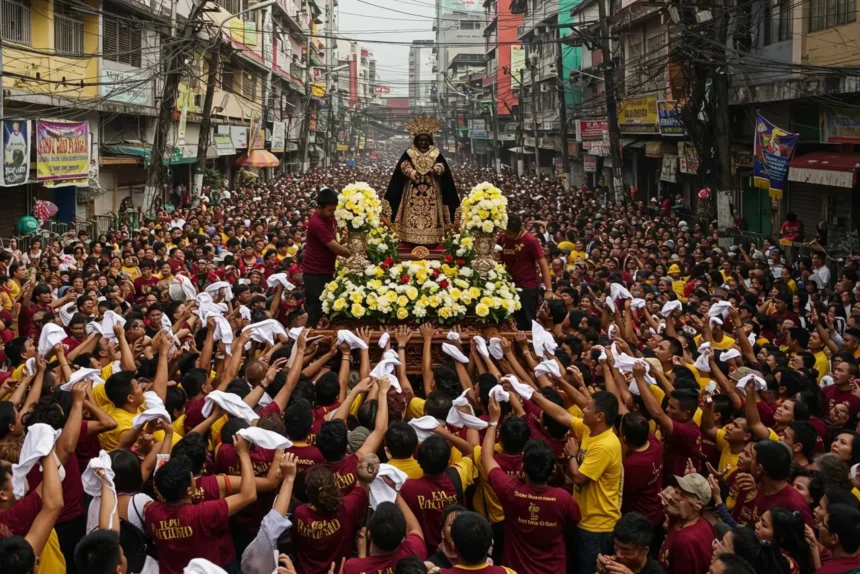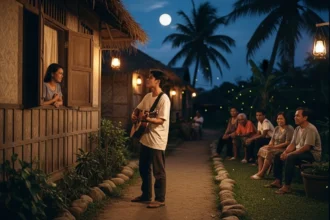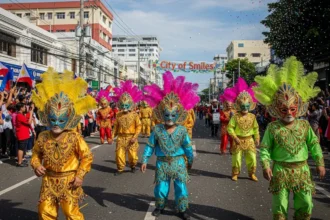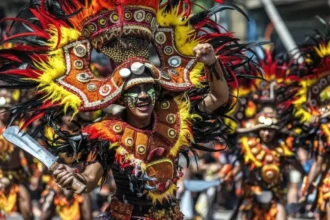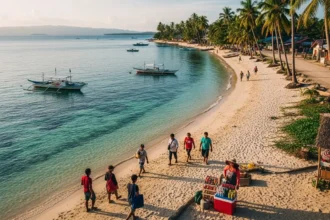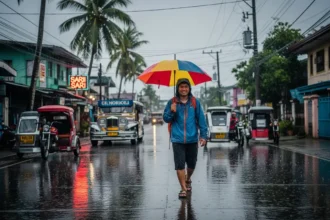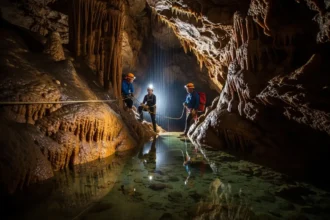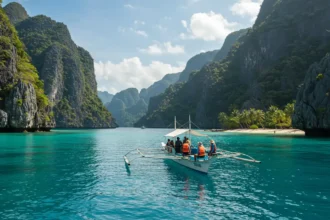Every January 9, the streets of Quiapo, Manila overflow with faith, sweat, and devotion as millions of barefoot devotees join the Feast of the Black Nazarene – one of the world’s largest religious processions.
For many Filipinos, this isn’t just a festival – it’s a promise kept. Some walk barefoot to fulfill a vow, others carry handkerchiefs hoping to touch the image of the Nazarene, believing it brings healing and miracles.
The Traslacion 2026 is expected to draw an even bigger crowd as the faithful return in full force post-pandemic. Whether you’re a pilgrim, a first-timer, or a curious traveler, this guide will walk you through the route, history, and heartfelt devotion that make the Black Nazarene Feast a uniquely Filipino act of faith.
📅 2026 Schedule & Key Events
The Feast of the Black Nazarene 2026 will be celebrated on Friday, January 9, in Quiapo, Manila, drawing millions of devotees from across the Philippines. The main highlight, the Traslacion, reenacts the 1606 transfer of the life-sized image of the Black Nazarene from Intramuros to Quiapo Church – a sacred journey now repeated every year in a procession of faith, endurance, and tears.
Here’s the full rundown of the 2026 celebration:
| Date (2026) | Event / Activity | What Happens |
|---|---|---|
| Jan 6–8 (Tues–Thurs) | Nazareno Novena Masses ⛪ | Daily novena and healing Masses at Minor Basilica of the Black Nazarene (Quiapo Church). Confessions and blessings available all day. |
| Jan 8 (Thursday) | “Pahalik” Rites 🙏 | The public kissing and touching of the Black Nazarene image held at Quirino Grandstand, Luneta. Thousands line up overnight to pray and pay homage. |
| Jan 9 (Friday) | Grand Traslacion Procession 🕊️ | Starts with a 4:00 AM Mass at Quirino Grandstand, followed by the Traslacion – the 6.5-km procession carrying the Black Nazarene back to Quiapo Church. The procession can last 15–20 hours. |
| Jan 10–11 (Sat–Sun) | Thanksgiving & Post-Feast Masses 🌅 | Final Masses at Quiapo Church to give thanks for a safe Traslacion and answered prayers. Lighter crowds, perfect for quiet reflection. |
🕓 Traslacion 2026 Route (Tentative)
The procession route usually follows this traditional path:
Quirino Grandstand → Katigbak Drive → Padre Burgos Avenue → Taft Avenue → McArthur Bridge → Palanca Street → Quezon Boulevard → Quiapo Church
Expect the image to move slowly, surrounded by thousands pulling the rope (lubid) – a symbolic act of sharing in Christ’s suffering.
Devotee’s Move – Find Your Spot Early
Devotees begin gathering as early as midnight of January 9. Good vantage points are Ayala Bridge, Palanca Street, and Arlegui, but always stay at the edges – the crowd surges when the image approaches.
🚨 Safety & Crowd Flow Notes
-
First Aid & Devotee Centers: Located along Jones Bridge, Lerma Street, and Recto Avenue.
-
Checkpoints: Expect bag inspections and crowd control barriers near Quiapo Church.
-
Cell Signal: Usually jammed during the peak of the procession for security – agree on meeting points with companions ahead of time.
Local Hack – Watch the Early Morning Departure
If you’re not joining the entire walk, the most beautiful and emotional moment is the early dawn send-off at Quirino Grandstand. You’ll hear thousands singing “Nuestro Padre Jesús Nazareno” in unison – goosebumps guaranteed.
🕊️ History & Devotion Behind the Black Nazarene
To understand the Feast of the Black Nazarene, you have to look beyond the crowd – beyond the ropes, the chants, and the barefoot pilgrims. At its heart is a centuries-old love story between the Filipino people and a dark-skinned image of Christ carrying His cross.
The image of the Black Nazarene was brought to the Philippines from Acapulco, Mexico, in 1606 by Augustinian Recollect missionaries. According to legend, the ship caught fire during the voyage, darkening the image’s complexion – a mark that Filipinos later embraced as their own.
Since then, the Nazarene’s black color has come to symbolize humility, resilience, and suffering – the very traits Filipinos see in themselves.
✝️ The Birth of the Traslacion
The first Traslacion (transfer) happened when the image was moved from Intramuros to Quiapo Church on January 9, 1787. What began as a simple relocation turned into an outpouring of faith – thousands followed the image on foot, crying and praying as they touched its carriage.
That same devotion lives on today, with millions joining the yearly Traslacion, hoping to touch even a corner of the rope or towel that brushes the image – believing it carries grace and healing.
Faith Insight – Touch is Prayer in Motion
For many, it’s not about superstition but connection. They believe that touching the Nazarene is like holding on to hope – a physical reminder that Christ walks with the weary.
🌅 The Meaning of Devotion
The Black Nazarene represents every Filipino who suffers yet continues to rise. Whether it’s a jeepney driver praying for safety, a mother asking for healing, or a student begging for guidance – everyone sees a reflection of their struggles in the face of the Nazareno.
Many devotees join barefoot, carrying towels, handkerchiefs, or replicas of the cross – personal symbols of their panata (vow). Some walk for hours in silence, others cry or sing hymns, but all move with one purpose: to thank, to ask, or to believe.
Devotee’s Reflection – Faith That Walks With You
A man once said, “I walk every year not to ask for miracles, but to say thank you for surviving another one.” That’s what makes the Traslacion sacred – it’s not about miracles falling from the sky; it’s about faith that keeps walking, no matter how heavy the cross.
🛐 The Black Nazarene and Filipino Identity
Over the centuries, the Black Nazarene has become a mirror of Filipino spirituality – resilient, emotional, and deeply personal. While the Church reminds devotees that faith goes beyond physical touch, it also recognizes the image as a living testament to Filipino hope and endurance.
Each January, as millions walk barefoot through the streets of Manila, the Black Nazarene reminds the world of one simple truth: faith in the Philippines is not quiet – it’s alive, noisy, and unstoppable.
🚶 How to Join the Traslacion (and What to Expect)
Joining the Traslacion isn’t like attending a parade – it’s joining a river of faith that moves through Manila’s narrow streets for more than 15 hours. It’s intense, emotional, and physically demanding – but for many devotees, it’s a promise they keep every year, no matter what.
If you’re planning to join the Black Nazarene Feast 2026, here’s how to prepare and experience it safely and meaningfully.
🕓 Before the Procession
-
Attend the Early Morning Mass – The celebration starts with a 4:00 AM Mass at Quirino Grandstand, led by Manila’s Archbishop. Arrive at least 2–3 hours early if you want space near the altar.
-
Bring Only Essentials – A small sling bag with your ID, face towel, bottled water, and small snacks. Leave jewelry and gadgets at home – pickpockets blend into the crowd.
-
Wear Light, Comfortable Clothes – Plain shirts, stretchable pants, or shorts. White and maroon are traditional colors; some wear Nazareno shirts or carry small replicas.
-
Go Barefoot (Optional) – Many devotees go barefoot as a form of penitensya or gratitude. If it’s your first time, wear light sandals for safety.
Devotee’s Move – Pack a Faith Kit
Include a small rosary, hand towel, and extra shirt in a ziplock. These will come in handy when you’re drenched in sweat or water from the fire trucks spraying the crowd.
🚶 During the Traslacion
-
Follow the Flow, Not the Image – The crowd can swell beyond control. Don’t push your way forward – move with the rhythm and stay aware of your surroundings.
-
Keep Hydrated and Calm – Free water stations and medic tents are scattered along the route. Avoid dehydration and fainting, especially under the midday sun.
-
Stay Away From Ropes if You’re a First-Timer – Only seasoned devotees should attempt to grab the lubid (rope). It’s sacred, but also dangerous – surges can cause injuries.
-
Join in Prayer or Song – If you can’t get close, close your eyes and pray where you stand. Sing the hymn “Nuestro Padre Jesús Nazareno” – it connects you to thousands praying with you.
Local Hack – Best View Without the Push
Stay near Ayala Bridge, Arlegui Street, or Lawton Plaza. You’ll still feel the intensity but can step back if it gets too packed.
🏨 Where to Stay Near Quiapo
| Area | Recommended For | Budget Range (per night) |
|---|---|---|
| Ermita / Malate | Easy access to Quirino Grandstand | ₱2,000–₱3,500 |
| Quiapo / Sta. Cruz | Devotees wanting to be close to the route | ₱1,500–₱2,800 |
| Intramuros / Manila Bay | Quieter area, short jeepney ride away | ₱2,500–₱4,000 |
Pilgrim’s Tip – Book Early (December)
Hotels and pension houses within walking distance of Quiapo get fully booked weeks before January 9. Many returning devotees reserve the same rooms year after year.
⚠️ Safety & Survival Reminders
✅ Follow MMDA and police directions – routes and barricades can change mid-procession.
✅ Bring identification and medical info if you have conditions like asthma or hypertension.
✅ Avoid standing under electrical lines or bridges during surges.
✅ Stay hydrated; drink at least 1 bottle of water every hour.
✅ Never climb lampposts, trees, or vehicles to get a better view – it’s unsafe and disrespectful.
Safety Note – Respect the Image and the People
The Black Nazarene procession is sacred. Avoid loud conversations, laughter, or selfies near the image. Locals say faith here is measured not by how close you get, but by how sincerely you walk.
💛 What Happens After
Once the Nazarene reaches Quiapo Church, devotees kneel, weep, and sing in thanksgiving. Some stay outside until dawn, praying for the year ahead. The church remains open 24 hours after the Traslacion for those offering candles and petitions.
Devotee’s Reflection – Faith You Can Feel
It’s loud, hot, and chaotic – but when you see the image pass, everything else fades. For that brief moment, it’s just you, your faith, and the man on the cross walking with you.
⚠️ Safety, Etiquette & First-Timer Tips
Every January 9, millions fill the streets of Manila to walk beside the Black Nazarene – some for healing, others for thanksgiving, many just to feel closer to Christ. But while the Traslacion is a spiritual journey, it’s also one of the most physically demanding events in the country. Staying safe and respectful ensures your pilgrimage becomes an act of faith, not an accident.
🚨 Crowd Safety Basics
-
Follow the Flow of the Devotees – Don’t move against the crowd. The human tide can be overwhelming, so follow the direction of movement and stay calm if it slows down.
-
Know the Exit Points – There are emergency lanes and safety routes along Palanca, Carlos Palanca Sr. Street, and Quezon Boulevard. Note them before joining.
-
Avoid the Center of the Crowd if You’re New – The middle area near the andas (carriage) is extremely dense. Watch from the outer lanes or bridges for your first year.
-
Stay Hydrated and Eat Light – Bring small snacks like crackers or bananas. Avoid heavy meals before joining – you might walk and stand for hours.
Local Wisdom – Pray Before You Enter the Crowd
Devotees often pause before joining the procession, making the sign of the cross or whispering a prayer: “Señor, ikaw na po bahala.” It’s a small act that centers you before the chaos begins.
🕊️ Procession Etiquette
-
No Selfies or Flash Photography – The procession is sacred. Focus on prayer and participation, not documentation.
-
Don’t Push or Shout Needlessly – The crowd moves best when everyone stays calm.
-
Respect Fellow Devotees – Offer space to elderly or barefoot participants. If someone faints, signal for help immediately.
-
Keep Quiet During Prayers – Join in singing the Nuestro Padre Jesús Nazareno hymn or pray silently.
Faith Reminder – Respect is Devotion in Action
The Black Nazarene teaches humility. The best devotees are those who don’t fight for a spot – they simply walk with faith, knowing that He sees everyone in the crowd.
💊 Health & Safety Stations
The City of Manila, Philippine Red Cross, and MMDA set up first aid tents and hydration stations throughout the route.
Look for them at:
-
Luneta / Quirino Grandstand
-
Lawton Plaza
-
Arlegui Street
-
Quezon Boulevard near Quiapo Church
Emergency Tip – Memorize One Landmark
Cell signal often goes down during the event. If you get separated from your group, agree on one meeting place (like Lerma underpass or Carriedo LRT Station) before the procession starts.
🕶️ For Observers & Tourists
If you’re not joining the walk but want to experience the event:
-
Watch from Ayala Bridge or Lawton Plaza – both offer a safe vantage point.
-
Dress modestly and avoid obstructing devotees or marshals.
-
Be mindful of your tone – what’s a spectacle to you is sacred to others.
Local Hack – Arrive Early, Leave Early
By 5:00 AM, streets begin closing and foot traffic doubles every hour. To avoid getting stuck, plan your arrival and exit windows carefully.
❤️ How to Prepare Spiritually
-
Attend a novena or confession before January 9.
-
Reflect on your personal panata (promise) and what it means.
-
Bring your own small replica or handkerchief to wave during the procession.
-
After the Traslacion, visit Quiapo Church again quietly – it’s emptier the next morning and perfect for reflection.
Pilgrim’s Reflection – Faith Is Not in the Distance
Even if you never touch the image, you’ll still feel its power. The miracle isn’t in reaching the Nazarene – it’s in walking with millions who believe that pain and faith can live side by side.
🧭 Travel & Practical Tips for Visiting Quiapo
Whether you’re joining the Traslacion or visiting the Black Nazarene on an ordinary day, Quiapo has its own rhythm – loud jeepneys, the scent of sampaguita and candles, and a mix of chaos and calm that only Manila can offer. Here’s how to move around safely, eat well, and make the most of your pilgrimage.
🚕 How to Get to Quiapo
| Mode of Transport | From | Details & Tips |
|---|---|---|
| Jeepney / UV Express | Cubao, Monumento, or Pasay | Get off at Quiapo Church or Quezon Blvd. Jeepneys with “Quiapo” signs are easy to spot but expect traffic. |
| LRT Line 1 / Line 2 | Anywhere in Metro Manila | Nearest stations: Carriedo (LRT-1) or Recto (LRT-2). Both are walking distance from the church. |
| Taxi / Grab | Metro Manila area | Tell the driver “Quiapo Church” or “Plaza Miranda.” Some roads close early during Traslacion, so expect to walk a few blocks. |
| Walking (for nearby guests) | Intramuros, Sta. Cruz, or Lawton | During the Traslacion, walking is the fastest and safest option once traffic locks down. |
Traveler’s Move – Go Early or Late
Mornings before 8 AM are calmest, while evenings after 7 PM are quieter and perfect for reflection. Avoid noon to mid-afternoon when traffic and heat peak.
🏨 Where to Stay Near Quiapo
| Area | Ideal For | Budget Range (₱/Night) |
|---|---|---|
| Sta. Cruz / Carriedo | Devotees wanting proximity | ₱1,200–₱2,500 |
| Ermita / Malate | Tourists & travelers seeking comfort | ₱2,000–₱4,000 |
| Intramuros / Binondo | Heritage & food enthusiasts | ₱2,500–₱5,000 |
Local Hack – Book in December
Hotels fill up weeks before January 9. For Traslacion week, try smaller inns around R. Hidalgo, Raon, or Recto – many offer short stays or pilgrim discounts.
🍲 What to Eat Around Quiapo
After hours of walking or praying, Quiapo’s street food is your reward.
Must-tries:
-
Pancit Palabok & Mami – From Ma Mon Luk or New Toho Food Center.
-
Suman, Kutsinta, and Bibingka – Vendors line Villalobos Street near the church.
-
Mangga with Bagoong – Sweet, tangy, and perfectly Pinoy.
-
Taho & Sorbetes – Sold around Plaza Miranda for a quick energy boost.
-
Halal Food Stalls – Near Golden Mosque for Muslim visitors and travelers.
Foodie Move – Try the Side Streets
Follow the aroma. The best meals are in nameless stalls behind the church – no menu, just home-style comfort food and the hum of prayers in the background.
🛍️ Where to Shop & What to Buy
Quiapo is Manila’s unofficial market of miracles and bargains.
-
Religious Souvenirs: Rosaries, Nazarene statues, scapulars, and prayer booklets sold near Plaza Miranda.
-
Herbal Remedies & Oils: Found along Quezon Blvd. – locals swear by lana (anointing oil) and tawas.
-
Electronics & Cameras: R. Hidalgo Street is famous for camera shops and repair stores.
-
Pasalubong Idea: Mini Black Nazarene images or “Nazareno shirts” – meaningful and affordable.
Budget Move – Bring Small Bills
Vendors often can’t give change for ₱1,000 notes, especially during festival week. ₱20s and ₱50s go a long way in Quiapo.
🚶 Bonus Side Trips
After visiting Quiapo Church, explore these nearby gems:
-
Binondo (Chinatown) – 10 minutes away; try dumplings and hopia.
-
Intramuros – Historic walled city of Manila; perfect for a quiet post-pilgrimage walk.
-
Divisoria Market – For bargain finds and pasalubong shopping.
-
Manila Baywalk – Sunset spot for peaceful reflection after a long day.
Local Secret – Visit on an Ordinary Friday
Every Friday, devotees still flock to Quiapo, though in smaller numbers. It’s the best day for prayer, reflection, and observing the devotion up close – minus the overwhelming crowds.
❓ FAQs About the Black Nazarene Feast 2026
1. When is the Feast of the Black Nazarene 2026 celebrated?
The Feast of the Black Nazarene 2026 will take place on Friday, January 9, in Quiapo, Manila. The main Traslacion procession begins early morning at Quirino Grandstand and ends at Quiapo Church late at night.
2. What is the Traslacion?
The Traslacion is the annual transfer of the Black Nazarene’s image from Quirino Grandstand back to Quiapo Church. It reenacts the 1787 relocation of the original statue and is now considered one of the largest religious processions in the world.
3. Why do devotees go barefoot during the procession?
Many devotees walk barefoot as a sign of penitence, humility, and gratitude. It’s a personal panata (vow) – a physical act of sacrifice in return for answered prayers or blessings.
4. What is the best viewing area for first-timers?
Good viewing spots include Ayala Bridge, Arlegui Street, and Lawton Plaza, where the image passes slowly but safely. Avoid the dense center near the andas if it’s your first time joining.
5. What should I wear during the Traslacion?
Wear light, comfortable clothing and avoid flashy or tight outfits. Most devotees wear maroon and yellow shirts – the traditional colors of the Black Nazarene.
6. Is it safe to bring my phone or camera?
Not recommended inside the main crowd. If you plan to take photos, stay at the edges of the route or near media areas where it’s safer and less crowded.
7. What’s the meaning behind the dark color of the image?
The image turned black after a fire on the ship that brought it from Mexico in 1606. Devotees believe its dark color represents Christ’s suffering and the resilience of the Filipino people.
8. How long does the procession usually take?
The Traslacion typically lasts 15–20 hours, depending on crowd movement and route conditions. The image often reaches Quiapo Church by midnight or early morning the next day.
9. How can tourists or non-devotees experience the event safely?
Watch from designated areas like Quirino Grandstand or Jones Bridge. Be respectful, dress modestly, and avoid blocking devotees or clergy during the procession.
10. Why is the Black Nazarene so important to Filipinos?
For many Filipinos, the Black Nazarene represents hope, endurance, and shared suffering. It’s a symbol of faith that walks with the poor, the weary, and those who never stop believing – even in hardship.
🌅 Walk With Faith, Not Just Your Feet
The Feast of the Black Nazarene isn’t about how close you get to the image – it’s about how far your faith takes you. Every year, millions walk barefoot through Manila’s heat and chaos, carrying stories of pain, gratitude, and hope. And somewhere between the sweat and the song, something sacred happens.
For a few moments, the city breathes as one. The sound of prayers rise above the crowd, and even strangers look out for each other. Because here, faith isn’t quiet – it moves, it weeps, it crawls, and it endures.
So when January 9, 2026 comes, don’t just watch from afar. Join the crowd, or simply whisper a prayer from wherever you are.
Because in Quiapo, faith doesn’t stand still – it walks with you, carries your burdens, and reminds you that you’re never alone. 🙏💛
🧭 References
-
Wikipedia – Feast of the Black Nazarene
-
Catholic News Agency – What is the ‘Black Nazarene’?
-
The Minor Basilica & National Shrine of Jesus Nazareno – Traslación & the Faith in Quiapo
-
The Philippine Star – Quiapo Church releases 10-day schedule for Nazarene feast
-
The Philippine News Agency – Nazareno 2025 to be celebrated nationwide in ‘historic’ first



